Jacopo della Quercia facts for kids
Quick facts for kids
Jacopo della Quercia
|
|
|---|---|
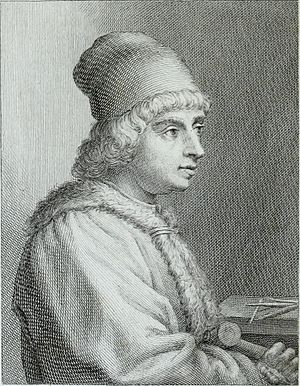 |
|
| Born |
Jacopo di Pietro d'Agnolo di Guarnieri
c. 1374 Quercegrossa near Siena, Republic of Siena
|
| Died | 20 October 1438 (aged 63–64) Siena, Republic of Siena
|
| Nationality | Italian |
| Known for | Sculpture |
|
Notable work
|
The Tomb of Ilaria del Carretto |
| Movement | Early Renaissance |
Jacopo della Quercia (born around 1374, died October 20, 1438) was a famous Italian sculptor from the Renaissance period. He lived at the same time as other great artists like Brunelleschi, Ghiberti, and Donatello. Some people even say he inspired Michelangelo later on!
Contents
Jacopo della Quercia's Life Story
Jacopo della Quercia got his name from Quercia Grossa, a place near Siena, Tuscany, where he was born in 1374. He learned his first art skills from his father, Piero d'Angelo, who was a woodcarver and goldsmith.
Jacopo probably saw the amazing sculptures by Nicola Pisano and Arnolfo di Cambio in the cathedral of Siena. These works likely influenced him a lot. One of his first projects might have been a wooden statue of a horse for a funeral when he was just sixteen.
In 1386, Jacopo and his father moved to Lucca because of some local troubles. It's thought that Jacopo also studied many old Roman sculptures in Pisa. These ancient artworks, along with the influence of artists like Donatello, helped him change his style. His art started in the Gothic style but then moved towards the new Italian Renaissance style.
Early Works and Competitions
One of Jacopo's earliest works, though some people aren't sure, is the Man of Sorrows in the Lucca cathedral. In 1401, he joined a big competition to design the bronze doors for Florence's Baptistery. However, he lost to Ghiberti. We don't know where Jacopo's design for the doors is now.
In 1403, he created a marble sculpture called Virgin and Child for the Ferrara cathedral. Another possible work from this time is a small statue of St. Maurelius. Both of these are now in the Museo del Duomo.
The Tomb of Ilaria del Carretto
Jacopo returned to Lucca in 1406. There, he was asked by the city's ruler, Paolo Guinigi, to create a tomb for his second wife, Ilaria del Carretto. This beautiful tomb is in the Lucca cathedral.
The tomb shows Ilaria dressed in rich clothes, resting on top of a stone coffin. She is shown in a delicate Gothic style, with her dog, a symbol of loyalty, at her feet. This tomb was one of the first signs of the new Renaissance art style beginning to appear.
Fonte Gaia: Siena's Joyful Fountain
| Fonte Gaia in Siena | ||
|---|---|---|
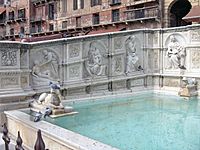 |
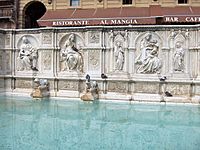 |
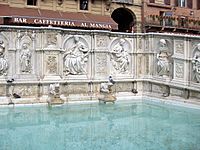 |
|
|
|
|
In 1406, Jacopo was asked to build a new fountain in the Piazza del Campo in Siena. This new fountain was meant to replace an older one that had a statue of the goddess Venus. People blamed the old statue for an outbreak of the Black Plague, so it was destroyed and buried outside the city.
This important job showed that Jacopo was already seen as Siena's best sculptor. The new rectangular fountain was made of white marble and was dedicated to the Virgin Mary. It had many statues and water spouts on its three sides.
Because Jacopo took on other projects at the same time, the fountain took a while to finish. He started in 1414, and it was finally ready in 1419. He carved the stone panels in a workshop next to the cathedral, which is now the Cathedral Museum. The fountain was called Fonte Gaia, meaning "Joyful Fountain," because of the celebrations when it started working. Today, it's a popular spot for tourists. The original statues were replaced with copies in 1858 and are now in a museum.
Other Important Works

In 1412, a rich merchant named Lorenzo Trenta hired Jacopo to design the Trenta Chapel in the Basilica di San Frediano in Lucca. Jacopo had some legal trouble and left Lucca for a while, working on the Fonte Gaia in Siena. He only returned to Lucca in 1416.
He continued working on the Trenta Chapel, creating a marble altar and several statues of saints in special spaces called niches. Jacopo also designed the flat tomb carvings for Lorenzo Trenta and his wife, which are on the floor in front of the altar.
Work on the Siena Baptistery
In 1416, Lorenzo Ghiberti was asked to design a bronze panel for the Baptistery in Siena. Because of some local disagreements, Jacopo della Quercia also joined the project. He only finished one bronze relief, called The Annunciation to Zacharias, because he was also busy with the Fonte Gaia and the Trenta Chapel. His slow progress on this project caused him some legal problems.
Jacopo had not won the competition for the famous "Doors of Paradise" in Florence, so he wasn't very keen on working with bronze. When he worked on the Baptistery's tabernacle (a small structure), he only wanted to handle the marble parts.
Wooden Sculptures
In 1421, Jacopo carved an Annunciation in a different style. It included two wooden statues, Virgin and Gabriel, for the Collegiata in San Gimignano. Other artists added the colors to these statues. The detailed work on this group showed that Jacopo was also very skilled at woodcarving. This has led some people to believe he made other wooden statues, but most of those were likely made by his busy workshop.
In his later years, Jacopo became even busier, working on several projects at once. In 1427, he was asked to design the upper part of the baptismal font for the Siena Baptistery. This tall, six-sided column has five prophets in niches. The marble statue of St. John the Baptist at the very top is also thought to be by Jacopo della Quercia.
Porta Magna: Bologna's Grand Door
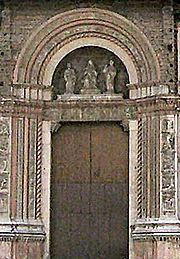
In 1425, Jacopo took on another huge project: designing the large, round-arched Porta Magna (Great Door) for the San Petronio church in Bologna. This project kept him busy for the last thirteen years of his life and is seen as his greatest work.
Each side of the door has a twisted column and then nine busts (head and shoulders sculptures) of prophets. Below these are five scenes from the Old Testament, carved in a slightly lower relief. In the Creation of Adam scene, Jacopo used a similar design to his Fonte Gaia in Siena, but in reverse.
Michelangelo, a very famous artist who visited Bologna in 1494, even said that his own Genesis scenes on the Sistine Chapel ceiling were based on these reliefs. Above the door, there are five more reliefs showing scenes from the New Testament. The space above the door, called the lunette, holds three freestanding statues: Virgin and Child, Saint Petronius (holding a model of Bologna), and Saint Ambrose. Jacopo worked closely with artists from his Bologna workshop on this project.
While working on the Porta Magna, Jacopo was also asked in 1434 to design the Loggia di San Paolo in Siena. He wasn't able to finish this job before he died. He had only completed the tops of the columns and six niches.
In his final years, Jacopo received many honors from the people of Siena. In 1435, he was made a knight and given an important job as the Operaio (manager) of the cathedral. Jacopo della Quercia passed away in Siena on October 20, 1438. He was buried in the San Agostino church in Siena.
Other artists of his time, like Lorenzo Ghiberti and Giovanni Santi, thought very highly of him. Giorgio Vasari even included a biography of Jacopo della Quercia in his famous book, Lives of the Artists.
Main Sculptures
Here are some of Jacopo della Quercia's most important works:
- An equestrian (horseback) wooden statue for a funeral (around 1400).
- Knight of San Cassiano (around 1400) - a wooden statue.
- Virgin and Child (Silvestri Madonna) (1403) - a marble sculpture in the Cathedral of Ferrara.
- The tomb of Ilaria del Carretto (around 1406) - in the Cathedral of Lucca.
- Fonte Gaia (1408–1419) - the famous fountain in Siena.
- Virtue (1409–19) - a marble sculpture in Palazzo Pubblico, Siena.
- Hope (1409–19) - a marble sculpture in Palazzo Pubblico, Siena.
- Annunciation, Virgin and Gabriel - wooden statues in the Collegiata di San Gimignano.
- polyptych (a many-paneled artwork) on the Trenta family altar (1422) - in the Basilica di San Frediano, Lucca.
- Porta Magna (1425) - the grand door at the Basilica di San Petronio, Bologna.
- Fountain panels and a small statue of John the Baptist (1427) - in the Baptistry of Siena's cathedral.
Images for kids
See also
 In Spanish: Jacopo della Quercia para niños
In Spanish: Jacopo della Quercia para niños




